There are a lot of ways in SharePoint that you can use to fetch the reports for the various data within SharePoint. You can also write some custom utilities but in this article, we are going to look into all the OOB report that SharePoint is providing to make our daily life easy.
1. SharePoint Online: Site Usage Report
- Go to your Site >> Site Content
- On the Site Content Page, click on Site usage from Top right corner.

- We will go through each section one by one.
- Unique Viewers: The number of people who have visited the site, regardless of how often they’ve visited. You can see the report for the last 7 days, 30 days or 90 days.
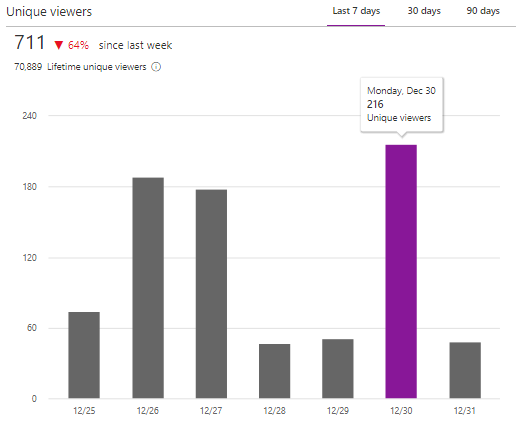
- Site visits: The number of visits to the site regardless of how many people visited. You can see the report for the last 7 days, 30 days or 90 days.
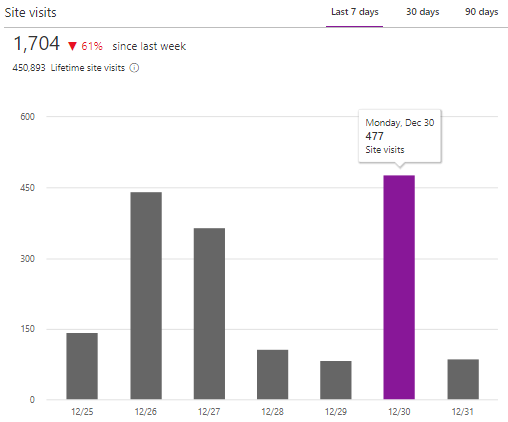
- Site traffic: It shows the traffic on a chart with weekdays on the Y-axis and Time/duration of the day on the X-axis. You can see the report for the last 7 days, 30 days or 90 days. For 30 and 90 days you will see an average of the site traffic.

- Popular platforms: It shows the device/platform (Desktop, Mobile, Tablet) wise traffic on a Bar chart. You can see the report for the last 7 days, 30 days or 90 days.

- Most unique viewers: It displays the content/page of the site and number of unique viewers for that page for the last 7 days.
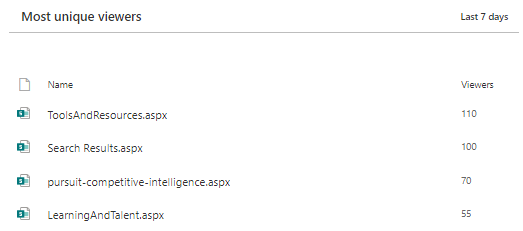
- Most viewed: It shows the most viewed content/page for the last 7 days and number of views for that content. You can see the report for the last 7 days.
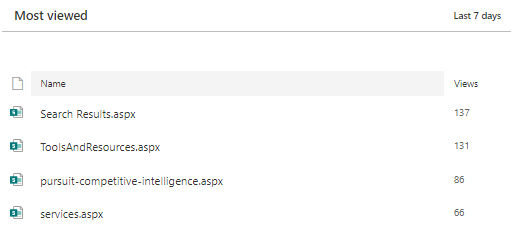
- Shared with external users: The content which is shared with external users.
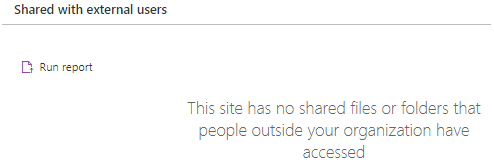
2. SharePoint Online: Site activity Report
- Go to Site content >> Site Pages library.
- Create a Site page
- Click on (+) to add a Web part. Add Site activity Web part
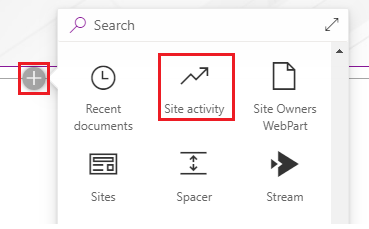
- All the View, Add and Edit activities done by the logged-in user, will be listed here.
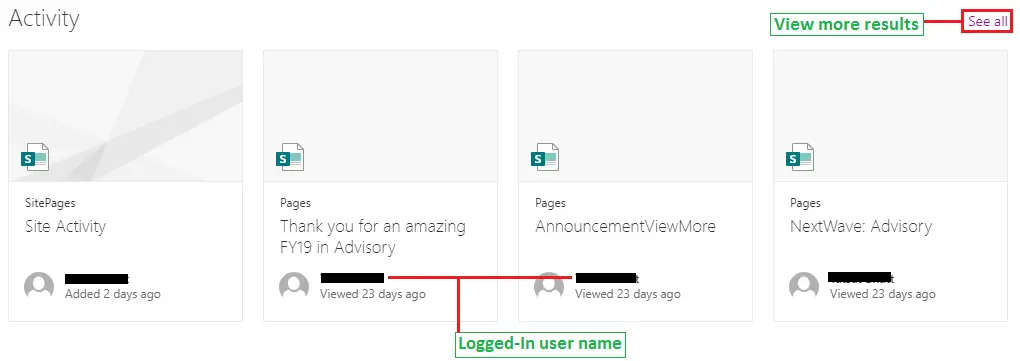
- As shown in the screenshot, you can view more results by clicking in See all.
3. SharePoint admin center: SharePoint file activity report
Go to https://tenantprefix-admin.sharepoint.com (SharePoint Admin Center).
- On the home page, you see a report section for file activity.
- This report shows the number of files Viewed/Edited, Synced, Shared internally and Shared Externally.
- If any of the activities mentioned above, occurs more than one time, that will be counted only ONE TIME for that day.
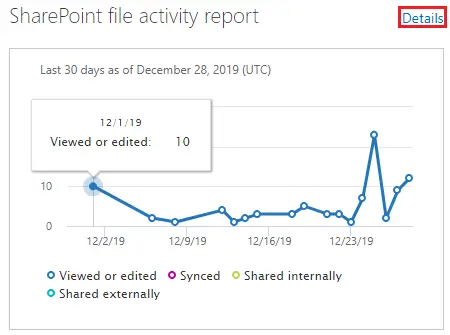
- If you click on Details, a report with various options will open.
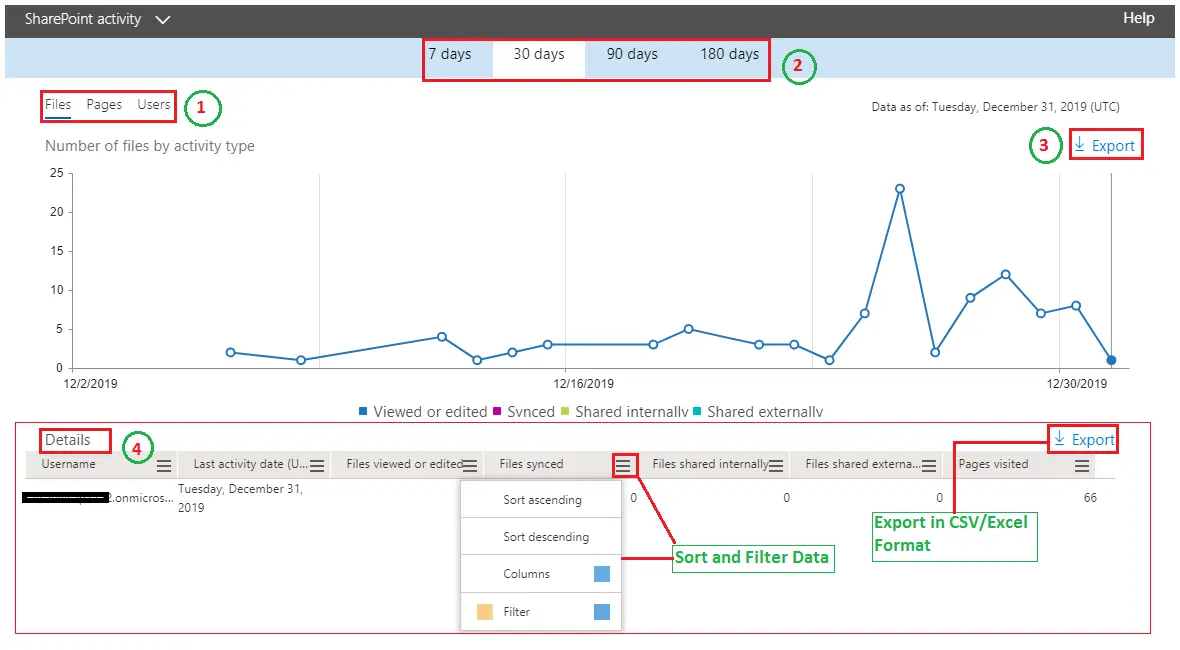
- Files/Pages/Users:
- Files: This will show the number of files by activity type, this is the report we saw on the home page.
- Pages: Number of unique pages visited by users. If any of the pages are getting opened more than one time by a particular user, that will be counted only ONE TIME for that day.
- Users: Number of active users will be displayed over here. The user who has either viewed, edited, Sync, Share or visited any page is considered an active user.
- Days: You can filter the report based on activities in the last 7 days, 30 days, 90 days or 180 days.
- Export: You can select any report and click on Export. The report will be exported in a .csv file format. You can open the file in excel.
- Details:
- If you go in the Details section as shown in the screenshot, You will find a few columns listed over there.
- You can apply Sorting and Filtering also using small breadcrumb given for each column.
- If you have more than 2000 users listed in the Details section, you can use an Export option given in the section. You can click on that and a detailed report in CSV format will be downloaded.
4. SharePoint admin center: SharePoint site usage report
- Go to https://tenantprefix-admin.sharepoint.com (SharePoint Admin Center).
- On the Admin center Home page, you can another report for site usage.
- This report shows the total number of sites in the tenant and the total number of active sites.
- If any user has performed any activity like View, Modify, Upload, Download, Delete, Add, Share or Sync then that particular site is considered Active Site.
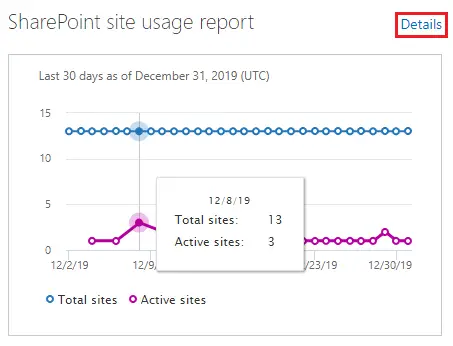
- Click on Details to see the drill-down report.
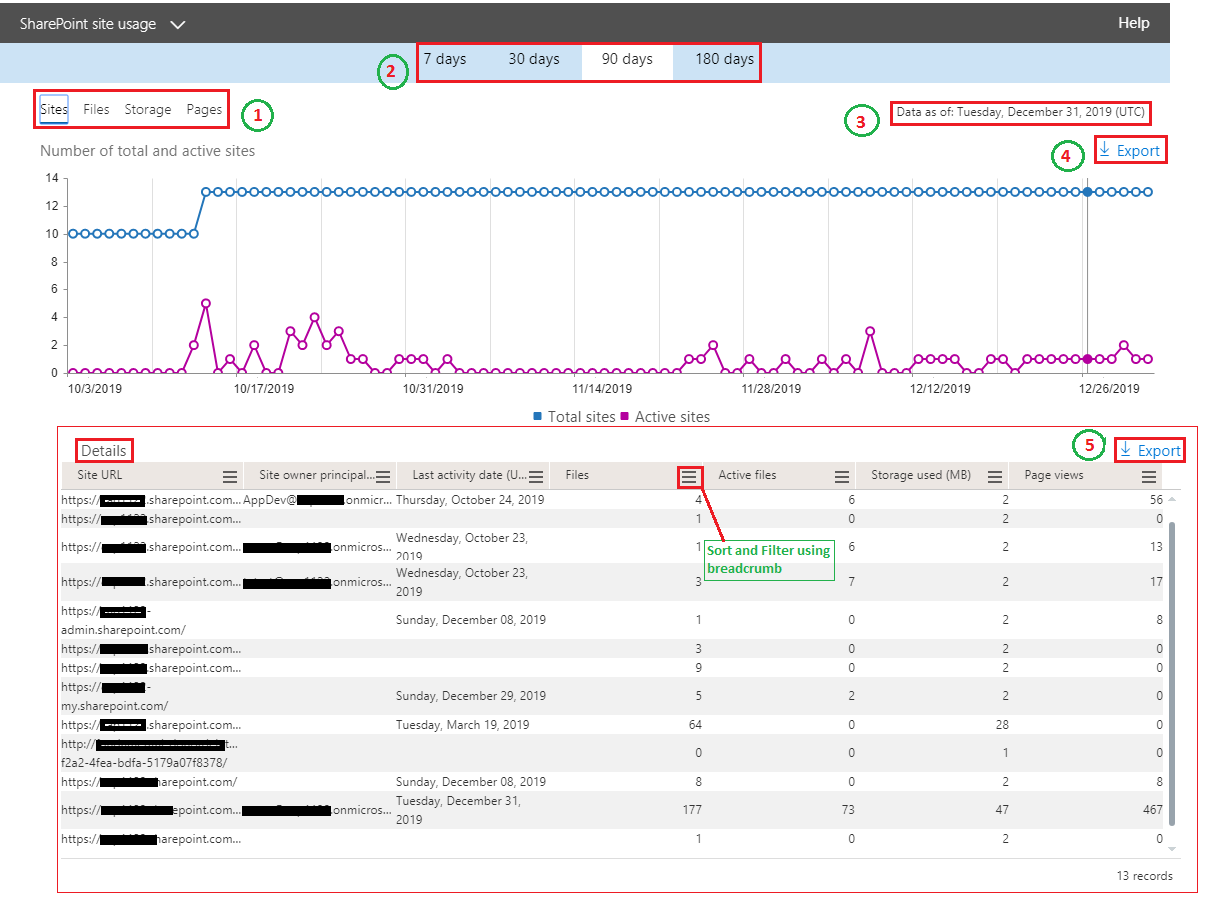
- Sites/Files/Storage/Pages:
- Sites: This report will show the number of Total and Active sites day by day. You can view the report for any particular day also just by clicking on a particular day in the graph.
- Files: This will show the number of total and active files throughout the tenant, across all the sites.
- Storage: This report will show the total amount of storage used by all the site resources.
- Pages: This report will show the total number of page views across all the sites in the tenant.
- Days: You can filter the report based on activities in the last 7 days, 30 days, 90 days or 180 days.
- Data as of: This is the date when the last time the data-presented was updated.
- Export: You can select any report and click on Export. The report will be exported in a .csv file format. You can open the file in excel.
- Details:
- If you go in the Details section as shown in the screenshot, You will find a few columns listed over there.
- You can apply Sorting and Filtering also using small breadcrumb given for each column.
- If you have more than 2000 sites listed in the Details section, you can use an Export option given in the section. You can click on that and a detailed report in CSV format will be downloaded.
NOTE: For SharePoint Admin Center reports:
- From Microsoft: You must be a global administrator in Office 365 or an Exchange, SharePoint, Skype for Business administrator, or reports reader to see reports.
- Reports typically don't include activity from the last 24 to 48 hours.
5. Audit log reports – SharePoint on-premises
- Go to Site settings >> Site collection audit settings under Site Collection Administration
- You can configure the audit log trimming here.
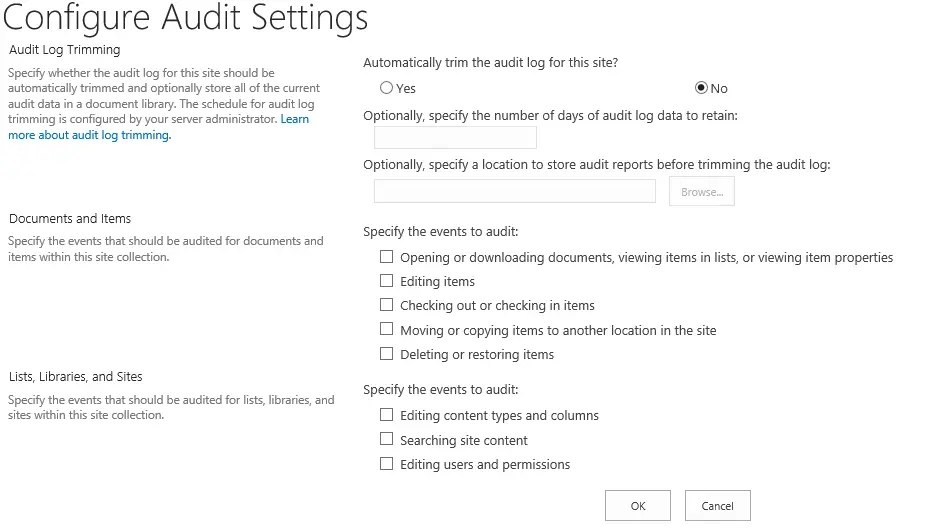
- Audit Log Trimming:
- Automatically trim the audit log for this site? – Tick yes, if you want to Automatically trim the audit log
- Optionally, specify the number of days of audit log data to retain: Specify the number of days after which the audit log will be deleted. The default number is 90 days.
- Optionally, specify a location to store audit reports before trimming the audit log: - specify a document library URL before trimming the log.
- Documents and Items: As you can see in the screenshot, specify the events that should be audited for documents and items within this site collection.
- Lists, Libraries, and Sites: Specify the events that should be audited for lists, libraries, and sites within this site collection.
- Go to Site settings >> Audit log reports under Site Collection Administration
- You will be able to see all the available reports. Click on one of them.
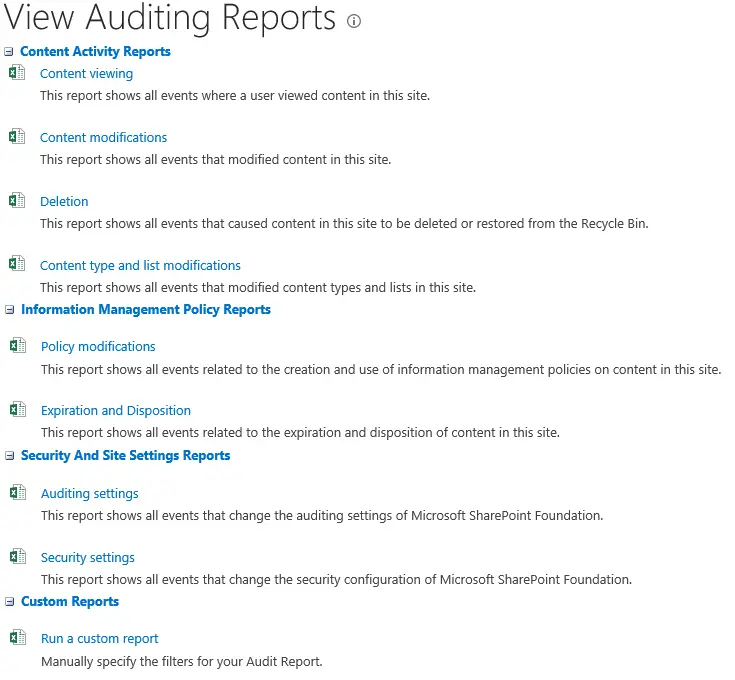
- Specify a location to store the report.

- Click on the link to go to the report.

- You can browse to the location and access the report.
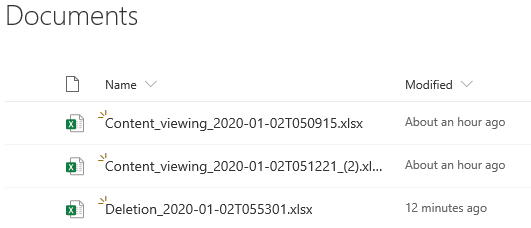
6. Audit log reports – SharePoint Online
- Go to Site settings >> Site collection audit settings under Site Collection Administration
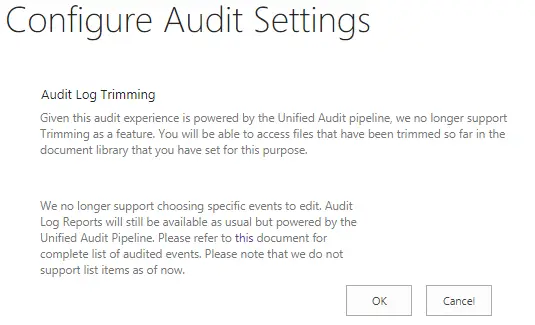
- As you can see in the screenshot, trimming is disabled. By default, trimming is ON in SharePoint online.
- Now, you cannot choose any specific auditing to be done on the site.
- As described in On-premises, you can still get the logs from Site settings >> Audit log reports under Site Collection Administration.
- List item support is also not available in SharePoint Online.
7. View SharePoint Online Audit logs using Unified Audit logs
You can browse the activities from admin and user in your O365 organization.
8. Site and Site Collection Usage Report
- Go to Site Settings
- For Site Report: Click on Popularity Trends under Site Administration
- For Site Collection Report: Click on Popularity and Search Reports under Site Collection Administration.
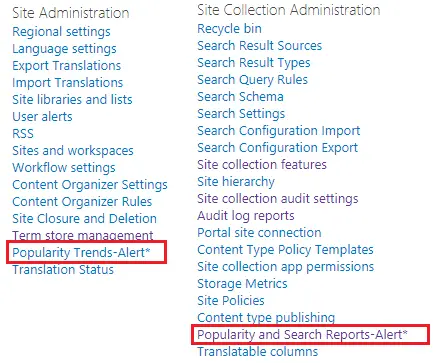
- We will open the Site Collection usage report.
- Click on Popularity and Search Reports.
- Click on the Usage report.

- This report shows site collection usage information, such as the number of views and unique users.
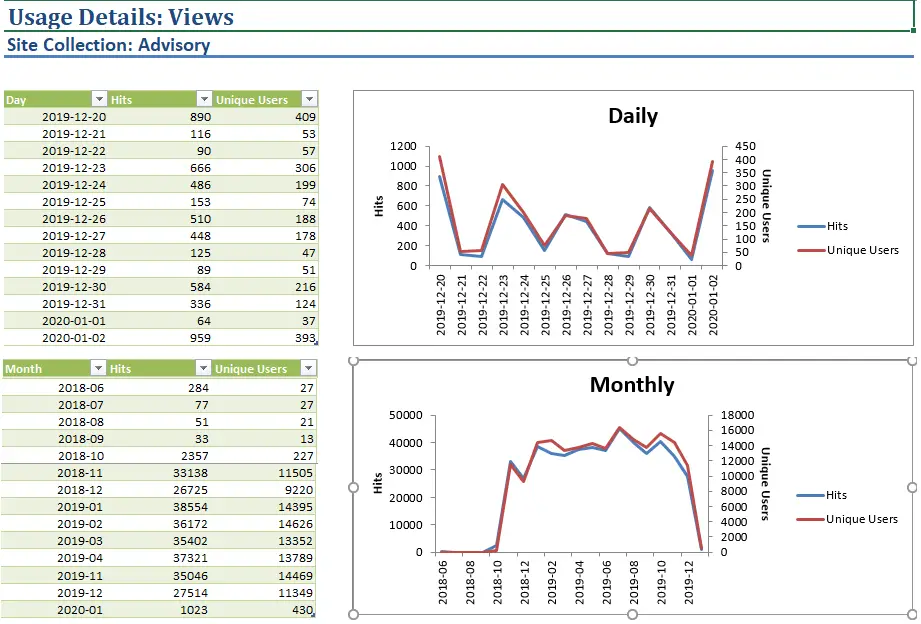
- You can explore the rest of the reports
9. Most popular items in Library
- You will see this option only in SharePoint Classic experience
- Go to a document library. Click on the LIBRARY from the Ribbon menu.
- This is a Library level report.
- Click on Most Popular items-Alert*. You can explore the results, this is self-explanatory.

- Look at the alert. It says this will not be available after Feb 2020.
10. Popularity trends for an Item
- You will see this option only in SharePoint Classic experience
- Go to a document library. Click on any of the list items and then FILES from the Ribbon menu.
- This is Item Level report
- Click on Popularity Trends-Alert*. You can explore the results, this is self-explanatory.

- Look at the alert. It says this will not be available after Feb 2020.
Please let us know in the comments below if we have missed ay OOB SharePoint report. We will again update this list.